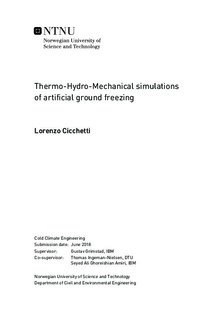| dc.description.abstract | Hundreds of thousands of people in Alaska, Canada, Russia, and Greenland live on permafrost,
which covers nearly 24% of the northern hemisphere (National Snow and IceData Center, 2018).
Living conditions can be challenged by the fragile nature of the frozen ground, especially if framed in the context of global warming. Indeed, permafrost effects like frost heave and thaw settlement may heavily affect existing buildings and transportation infrastructures such as roads, railways, embankments, and runways. These being vital for isolated Arctic communities, should be preserved and maintained. Artificial Ground Freezing (AGF) can be employed to keep soil frozen and hence ensure structure stability by means of one-way heat pipe systems, also called thermosyphons. Such devices have been widely used in China where permafrost degradation of the Tibet plateau posed severe threats to the normal functioning of the Qinghai-Tibet railway (Mu et al., 2016b). Also, Greenlandic infrastructure system is facing the same problems. The airport and many buildings in the settlement of Kangerlussuaq are for example threatened by the shifting thermal regime of the underneath soil and are in need of maintenance. Artificial ground freezing is also used nowadays as a valuable and efficient construction method for underground engineering projects in densely urbanized areas, due to the enhanced soil strength and decreased permeability it provides. This technique allows forming earth support systems covering a variety of geotechnical problems such as structural underpinning for foundation improvement, tunnel constructions and temporary control of groundwater flow in construction processes. A good example is the construction of Naples underground in Italy, where artificial ground freezing has been successfully applied. Thus, it seems clear that the interest in frozen ground engineering, whether soil freezing is induced by natural conditions or by human activities,
has rapidly developed over the last decades and it is expected to continue growing.
To predict the coupled thermo-hydro-mechanical (THM) behavior of frozen soil and to provide
a reliable design tool for geotechnical engineers, the development of a numerical modeling
approach is necessary. To this purpose, Ghoreishian Amiri et al. (2016b) developed a new
constitutive THM model able to capture different behaviors of frozen soil and predict mechanical response under different loading conditions and variations of temperature. This model will be used in this MSc thesis to replicate monitoring results of a large-scale artificial ground freezing project, that is the construction of platform tunnels in Naples Underground. This aims to further validate the robustness and the correct theoretical implementation of the model when applied to more advanced case studies. | |

